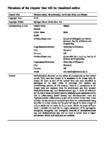Methanotrophy, Methylotrophy, the Human Body and Disease
| dc.contributor.author | Boden, Rich | |
| dc.date.accessioned | 2020-09-15T11:46:35Z | |
| dc.date.available | 2020-09-15T11:46:35Z | |
| dc.date.issued | 2018-11-30 | |
| dc.identifier.uri | http://hdl.handle.net/10026.1/16336 | |
| dc.description.abstract |
Methylotrophic Bacteria use one-carbon (C1) compounds as their carbon source. They have been known to be associated to the human body for almost 20 years as part of the normal flora and were identified as pathogens in the early 1990s in end-stage HIV patients and chemotherapy patients. In this chapter, I look at C1 compounds in the human body and exposure from the environment and then consider Methylobacterium spp. and Methylorubrum spp. in terms of infections, its role in breast and bowel cancers; Methylococcus capsulatus and its role in inflammatory bowel disease, and Brevibacterium casei and Hyphomicrobium sulfonivorans as part of the normal human flora. I also consider the abundance of methylotrophs from the Actinobacteria being identified in human studies and the potential bias of the ionic strength of culture media and the needs for future work. Within the scope of future work, I consider the need for the urgent assessment of the pathogenic, oncogenic, mutagenic and teratogenic potential of Methylobacterium spp. and Methylorubrum spp. and the need to handle them at higher containment levels until more data are available. | |
| dc.format.extent | 245-264 | |
| dc.language.iso | en | |
| dc.publisher | Springer Nature Switzerland | |
| dc.relation.ispartof | Health Consequences of Microbial Interactions with Hydrocarbons, Oils, and Lipids | |
| dc.rights | Attribution-NonCommercial-NoDerivatives 4.0 International | |
| dc.rights | Attribution-NonCommercial-NoDerivatives 4.0 International | |
| dc.rights | Attribution-NonCommercial-NoDerivatives 4.0 International | |
| dc.rights.uri | http://creativecommons.org/licenses/by-nc-nd/4.0/ | |
| dc.rights.uri | http://creativecommons.org/licenses/by-nc-nd/4.0/ | |
| dc.rights.uri | http://creativecommons.org/licenses/by-nc-nd/4.0/ | |
| dc.subject | Cancer | |
| dc.subject | 2.1 Biological and endogenous factors | |
| dc.subject | Infection | |
| dc.title | Methanotrophy, Methylotrophy, the Human Body and Disease | |
| dc.type | chapter | |
| plymouth.publication-status | Published | |
| dc.identifier.doi | 10.1007/978-3-030-15147-8_19 | |
| plymouth.organisational-group | /Plymouth | |
| plymouth.organisational-group | /Plymouth/Faculty of Science and Engineering | |
| plymouth.organisational-group | /Plymouth/Faculty of Science and Engineering/School of Biological and Marine Sciences | |
| plymouth.organisational-group | /Plymouth/REF 2021 Researchers by UoA | |
| plymouth.organisational-group | /Plymouth/REF 2021 Researchers by UoA/UoA06 Agriculture, Veterinary and Food Science | |
| plymouth.organisational-group | /Plymouth/Users by role | |
| plymouth.organisational-group | /Plymouth/Users by role/Academics | |
| dc.publisher.place | Cham, Switzerland | |
| dc.rights.embargoperiod | Not known | |
| rioxxterms.versionofrecord | 10.1007/978-3-030-15147-8_19 | |
| rioxxterms.licenseref.uri | http://creativecommons.org/licenses/by-nc-nd/4.0/ | |
| rioxxterms.type | Book chapter |



